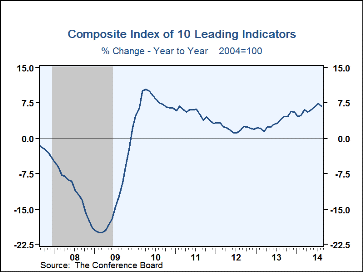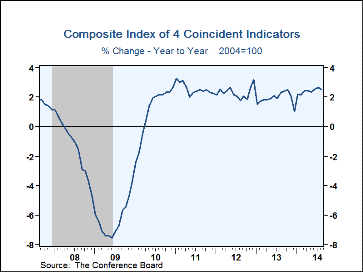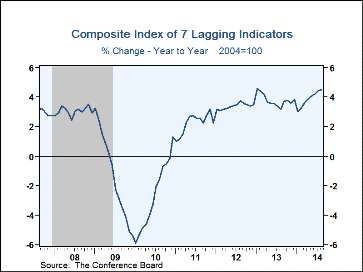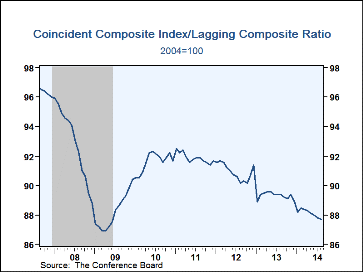 Global| Sep 19 2014
Global| Sep 19 2014U.S. Leading Economic Indicators Index Continues to Improve
by:Tom Moeller
|in:Economy in Brief
Summary
The Index of Leading Economic Indicators, from the Conference Board, gained 0.2% during August (6.8% y/y) following a revised 1.1% July rise. The latest improvement was the least since January's slight decline. The series was, [...]
The Index of Leading Economic Indicators, from the Conference Board, gained 0.2% during August (6.8% y/y) following a revised 1.1% July rise. The latest improvement was the least since January's slight decline. The series was, nevertheless, at the highest level since September 2007 and the y/y gain of 6.8% was off just slightly from its 7.4% peak. Half of the component series improved m/m, the least since April. Nevertheless, more than three-quarters of the components are up over the last six months. A steeper interest rate yield curve, a stronger ISM new orders index and the leading credit index provided the lift to last month's total gain. Higher initial claims for jobless insurance and fewer building permits detracted from the series change. Most other components were unchanged.
The index of coincident indicators rose 0.2% (2.5% y/y) after a 0.1% uptick. Three quarters of the component series increased after all rose during each of the prior six months. Nonfarm payroll employment, personal income less transfers and industrial production each rose last month but business sales fell minimally.
The lagging indicators index gained a steady 0.3% and lifted the y/y rise to a strengthened 4.5%. A shortened average duration of unemployment and more C&I loans outstanding have been steadily lifting the index.
The index of coincident-to-lagging indicators is a measure of how the economy is performing versus its excesses. It continued to fall last month, as it has since 2010.
The Conference Board figures are available in Haver's BCI database; the components are available there, and most are also in USECON. The forecast figures for the Consensus are in the AS1REPNA database. Visit the Conference Board's site for coverage of leading indicator series from around the world.
| Business Cycle Indicators (%) | Aug | Jul | Jun | Y/Y | 2013 | 2012 | 2011 |
|---|---|---|---|---|---|---|---|
| Leading | 0.2 | 1.1 | 0.7 | 6.8 | 3.5 | 2.2 | 5.3 |
| Coincident | 0.2 | 0.1 | 0.3 | 2.5 | 1.9 | 2.3 | 2.6 |
| Lagging | 0.3 | 0.3 | 0.4 | 4.5 | 3.8 | 3.4 | 2.3 |
Tom Moeller
AuthorMore in Author Profile »Prior to joining Haver Analytics in 2000, Mr. Moeller worked as the Economist at Chancellor Capital Management from 1985 to 1999. There, he developed comprehensive economic forecasts and interpreted economic data for equity and fixed income portfolio managers. Also at Chancellor, Mr. Moeller worked as an equity analyst and was responsible for researching and rating companies in the economically sensitive automobile and housing industries for investment in Chancellor’s equity portfolio. Prior to joining Chancellor, Mr. Moeller was an Economist at Citibank from 1979 to 1984. He also analyzed pricing behavior in the metals industry for the Council on Wage and Price Stability in Washington, D.C. In 1999, Mr. Moeller received the award for most accurate forecast from the Forecasters' Club of New York. From 1990 to 1992 he was President of the New York Association for Business Economists. Mr. Moeller earned an M.B.A. in Finance from Fordham University, where he graduated in 1987. He holds a Bachelor of Arts in Economics from George Washington University.










